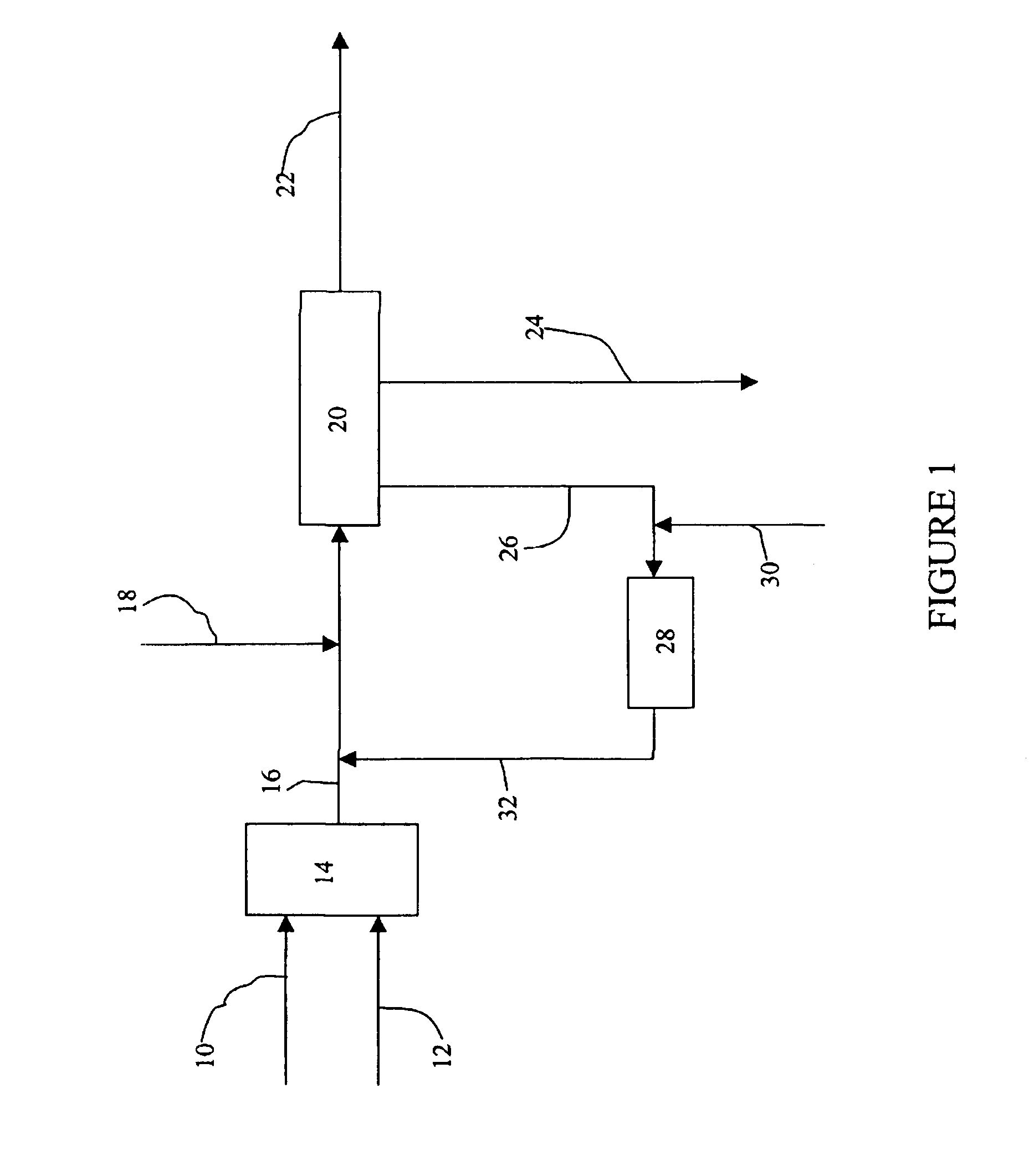Method and system for purifying cumene hydroperoxide cleavage products
a technology of cumene hydroperoxide and purification method, which is applied in the field of phenol production, can solve the problems of reducing and affecting the quality of cumene hydroperoxide products for many end-use applications, and achieves the effect of higher boiling point materials
- Summary
- Abstract
- Description
- Claims
- Application Information
AI Technical Summary
Benefits of technology
Problems solved by technology
Method used
Image
Examples
example 2
A second trial was conducted utilizing the same raw materials and conditions used in Example 1, except that the decomposer vessel 28 was operated at the following parameters: 135.degree. C., 6 atm pressure, and 1 hour residence time. Again, as in Example 1, an oxidizing agent was not utilized. The hydroxyacetone content in the resultant heat and pressure treated, non-oxidized aqueous phase stream was measured at 870 ppm. This concentration represents a 44.6% hydroxyacetone conversion when employing elevated heat treatment and super atmospheric pressure conditions. Following recirculation of the heat and pressure treated, non-oxidized aqueous phase stream, and re-equilibration within neutralizer reactor 20, the hydroxyacetone concentration of neutralized cleavage product stream 22 was measured at 1090 ppm.
example 3
A third trial was conducted utilizing the same raw materials and conditions used in Example 1, except that a hydrogen peroxide oxidizing agent was utilized. The hydrogen peroxide oxidizing agent was added to decomposer vessel 28 as a 30 wt. % aqueous solution in an amount effective to establish a 0.5 wt. % hydrogen peroxide concentration. The hydroxyacetone concentration of the resultant oxidized aqueous phase stream 32 was measured at 210 ppm. This concentration represents an 85.8% hydroxyacetone conversion to water-soluble oxidized derivatives. Following recirculation of oxidized aqueous phase stream 32 and reequilibration within neutralizer drum 20, the hydroxyacetone concentration of the neutralized cleavage product stream 22 was measured at 690 ppm. The acetaldehyde concentration of the oxidized aqueous phase stream 32 was measured at 120 ppm, representing a 60% acetaldehyde conversion. A qualitative analysis of oxidized aqueous phase stream 32 and aqueous phase purge 24 using ...
example 4
A second trial based upon Example 3 was conducted utilizing the same raw materials and conditions of Example 3, except that decomposer vessel 28 was charged with a 0.06 wt. % sodium hydroxide aqueous solution in addition to the 0.5 wt. % hydrogen peroxide oxidizing agent. A qualitative analysis measured a hydroxyacetone concentration of 108 ppm in oxidized aqueous phase stream 32. This concentration represents a 92.7% hydroxyacetone conversion to water-soluble oxidized derivatives. Following recirculation of oxidized aqueous phase stream 32 and re-equilibration within neutralizer drum 20, a qualitative analysis of neutralized cleavage product mixture 22 indicated a hydroxyacetone concentration of 590 ppm and an acetaldehyde concentration of 110 ppm. A qualitative analysis of aqueous phase purge 24 indicated a pyruvic acid sodium salt concentration of 812 ppm, and a sodium acetate concentration of 1250 ppm.
PUM
| Property | Measurement | Unit |
|---|---|---|
| weight percent | aaaaa | aaaaa |
| pressure | aaaaa | aaaaa |
| time | aaaaa | aaaaa |
Abstract
Description
Claims
Application Information
 Login to View More
Login to View More - R&D
- Intellectual Property
- Life Sciences
- Materials
- Tech Scout
- Unparalleled Data Quality
- Higher Quality Content
- 60% Fewer Hallucinations
Browse by: Latest US Patents, China's latest patents, Technical Efficacy Thesaurus, Application Domain, Technology Topic, Popular Technical Reports.
© 2025 PatSnap. All rights reserved.Legal|Privacy policy|Modern Slavery Act Transparency Statement|Sitemap|About US| Contact US: help@patsnap.com

